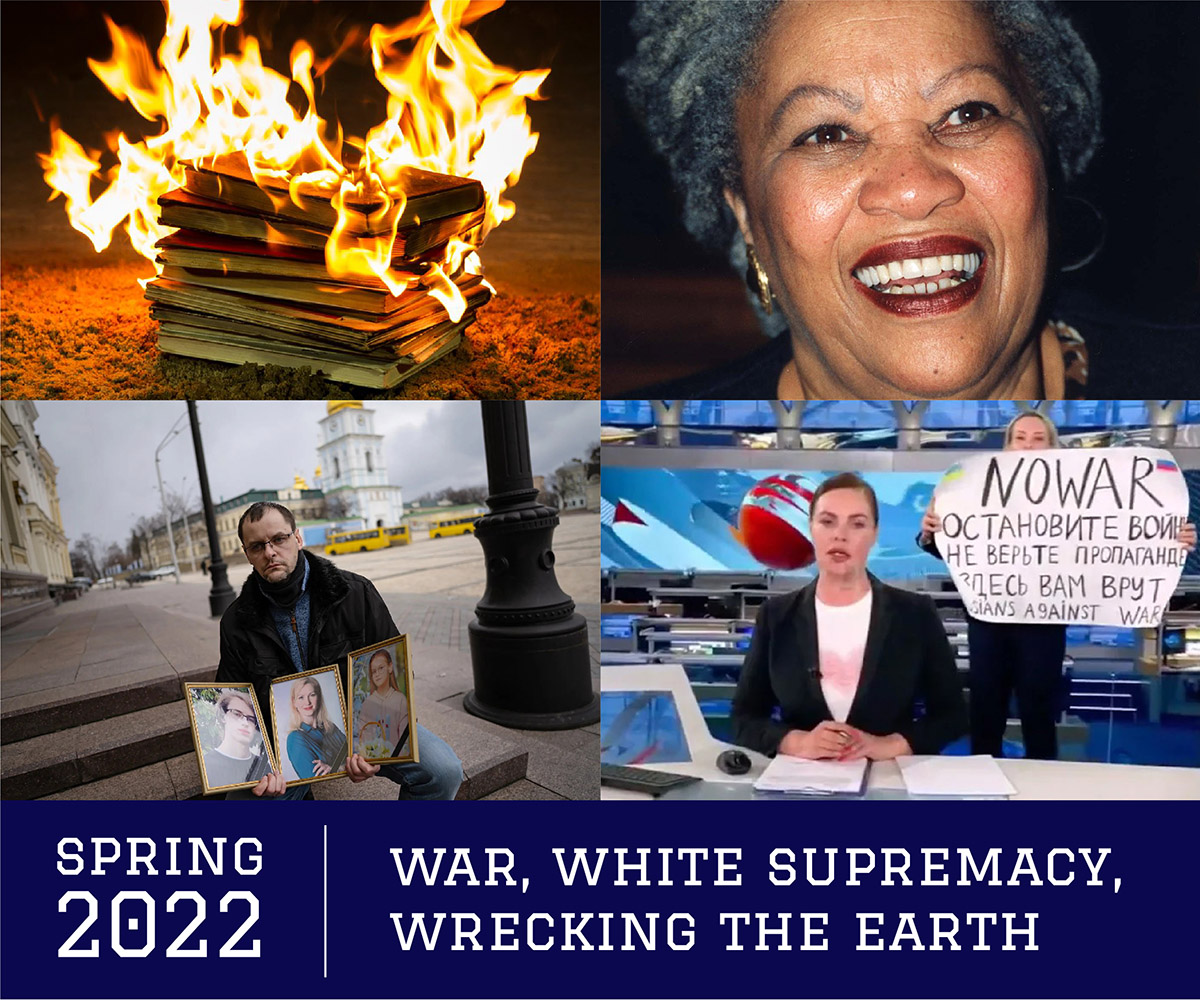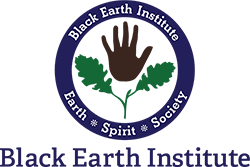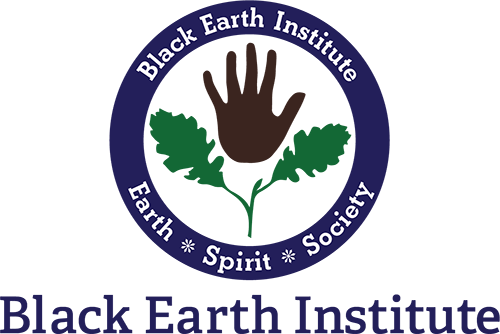
Photo credits, clockwise from upper left: Time Magazine, Wikipedia, CBC, The Boston Globe
BY ALEXIS LATHEM
In the winter of 2002-03, when W. Bush was preparing to invade Iraq, Lake Champlain froze over for the first time in many years– the little “great” lake that stretches 121 miles along the New York-Vermont border from its source in Canada. Politically, it was also a season of extreme weather, of a prolonged preamble to war that felt unprecedented. Long enough for a counter-culture to have grown up, here in the frozen north, where peace vigils took place on Friday nights on just about every snow-encrusted town green, and in Saturday night coffee houses a Phil Ochs style protest music was having its revival. Readings of Lysistrata were held in ten locations around the state, including Vermont’s largest theater space, packed to standing room only; followed by the inauguration of Vermont’s state poet, Grace Paley, who received a standing ovation after reading her anti-war poems under the golden dome; and finally, a Peace-on-Ice action in which more than two hundred people formed human peace insignias on the frozen surface of Lake Champlain.
I was particularly drawn by the idea of this action because it felt like an answer to the scientists at the research station in Antarctica who did this – the idea that the peace movement had reached the most remote corners of the globe filled me with hope. Forming peace signs on ice felt like a telegraphic kind of communication across vast distances, like smoke signals, with symbols that could be universally understood.
When I arrived at the ferry dock in the morning the group had already headed out; I looked for a human circle but saw only a raggedy group drifting across the ice toward New York. I passed a woman putting on her skates and realized how foolishly unprepared I was, but I headed out anyway to catch up with the group. It was a magnificent day, the lake ringed by mountains in shining snowcaps, shouldered by cedar-covered cliffs. The surface was elaborately patterned with a mosaic of cracks, in places transparent enough to see bubbles below the surface, in others creamy and scalloped like meringue. At one point I had to cross a huge pressure crack, where chunks of ice had piled up in a waist-high jumble, like an old stone wall fallen into disrepair. A moving current of water rippled around it, forming wading pools and puddles. It would be sheer foolishness to cross, I thought, but the others had crossed and so I proceeded, and soon I’d caught up with them, who were forming a circle over an area the size of a hockey rink.
I had been to countless protests in Vermont and had come to know the crowd, so I expected to see many familiar faces. But these were all new; I recognized only Kim and Wendy from the Peace and Justice Center. Many had come over from the sleepy town of Essex, New York, which practically folds out of existence in winter — almost two hundred of them had turned out to make their mark on the frozen lake. Someone was trying to organize us into formation. “Spread out!” she called. “Link up!” yelled another. “Form a line in this direction!” A buoyant mood had possessed us, as if we forgot the seriousness of our purpose. We were mildly delirious, maybe, from the beauty of our surroundings and the strange unlikeliness of standing where we were, in the middle of Lake Champlain, over water hundreds of feet deep.
Finally we had formed our peace sign, and when a plane approached, we laid down on the ice, head to foot. Our parkas and hats and scarves and sleds formed multicolored ribbons across the pale ice. Kim pulled out a bottle of wine and raised it in the air. “French wine!” she hollered. “And bread! To celebrate the French opposition to the war!” We were all in shavasana, facing the sky as if floating, suspended. I discerned a faint, pale half-moon overhead, which appeared to be smiling down on us. Another plane circled over us, CNN. And another, the Burlington Free Press.
I was interviewed by a young man from a local cable access station. But it felt strange to be talking about this. War? Even Burlington seemed distant.
A handful of us decided to cross to the New York side of the lake to join another group, who also planned to form a human peace sign. It was a long walk, a greater distance than it looked. The wind had picked up by the time we approached the New York shore, where a small group had gathered on the rocks, and where a television crew focused on the one counter-protester among them, a retired army colonel who held a sign saying “Support Our Troops.” He will be sure to get equal time, I thought. For balance.
The group multiplied magically, and soon some hundred and fifty human bodies had formed a peace sign: hatless teenage girls in blue jeans, families with young children. I talked to an elderly couple who drove an hour and a half to be there. They crossed the ice cautiously with the help of ski poles but no crampons, bullied about by the wind. After we made our peace sign we formed ourselves into a more ambitious arrangement, spelling out: NO WAR.
At the tail end of the “R”, a woman turned to me who apparently needed to rant. She was a well-coiffed woman with a ski-lift ticket dangling from her fancy parka, the type you might expect to meet on the slopes or at the mall, not at a peace rally. She is really angry and once she starts there’s no stopping her. “What makes me so mad,” she steamed, “is that Bush and Cheney and their gang stand to profit from this war. Halliburton and the Carlisle Group will cash in on weapons deals and are poised to cap those oil wells…”
In truth, hearing those reasoned arguments only made me despair. We were up against a government for whom war is peace; for whom killing Iraqis is caring about Iraqi lives; a government who must ignore the democratic protests of the world’s millions in order to save democracy. Power itself is proof of divine mandate. Bush’s war on Iraq was a military wager of theological consequence: Stop me if you can.
Though it felt strangely incongruous to be discussing war while sliding across this immense ice rink, the fragility of natural ecologies seemed more than ever to be intricately related to political ecologies. For a moment, we reached out across political boundaries — in the way that the peace movement had miraculously grown across a divided globe — and we blurred them. We could skate and slide and dance them out of existence. It felt dreamy and unlikely to be there where normally we shouldn’t be, couldn’t be, suspended over hundreds of feet of water. Meanwhile, beneath us the ice buckled and moaned.
I was anxious about finding my group to head back with. There was a sign on the shore warning: NO ICE IS SAFE ICE. I took none of the precautions it advised: to carry screwdrivers or other tools to help you climb out of the ice should you fall through, blankets or extra clothes. I excused myself and slid off in search of Kim.
A few weeks later the ice had begun to thaw and crack wide open, and bodies were falling in Iraq. I knew that a chain of violence would follow violence with greater certainty than I knew spring would follow winter. There would be no surprises, nothing that was not fully foreseen and forewarned. A half a lifetime of political dissent and so few victories. But the end is not the truth of the beginning; the war story is not the only story to tell: we have these stories of struggle. And maybe, after all, as the Ibo proverb says, it is the struggle that matters in the end. It does seem like a dream, that extra-ordinary season. Did we really join hands like that with strangers, moving carelessly over rumbling ice? Yes, we did. And was the world ever really so beautiful, at least somewhere on earth, at peace?

